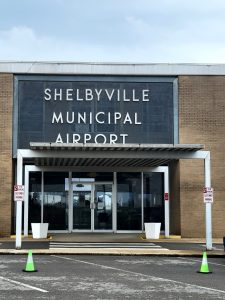BY MARK MCGEE
mmcgee@bedfordcountypost.com
 Just like the city and county, the Shelbyville Municipal Airport is dealing with growth issues of its own.
Just like the city and county, the Shelbyville Municipal Airport is dealing with growth issues of its own.
Paul Perry, airport director, is welcoming the expansion on all fronts, but like city and its planning issues there needs to be more awareness of what the airport requires.
“We have a great base here, but it always seems like we are constantly catching up because of lack of funding or something like that,” Perry said. “We haven’t been able to take advantage of the incredible growth here in Middle Tennessee.
“I could keep building hangars. Most people talk about the expense but if we had built more hangars 10 years ago or even five years ago it would have been more affordable. We would have been able to keep up with the growth. But everybody can look back and have 20-20 sight.”
Like one of the rules for real estate sales, growth in the area is all about location, location, location.
“Middle Tennessee airports are seeing a lot of demand than some of the more outlying areas in west and east Tennessee,” Perry said. “We have phone calls on a regular basis from people looking to move to Tennessee but they also want to find a place for their airplane, both business and personal.
“They know they want to be in Middle Tennessee because there is so much to do. They are struggling to find a place for their airplanes. Demand for space is out there.”
Two privately-owned flight schools are Tennessee Flight Training and Hawkins Flight Academy that are based here. But they have four others using the airport on a regular basis as well.
Perry explains there are three main reasons why the Shelbyville Municipal Airport is so attractive, especially for student training.
“One is the fact it is safe,” Perry said. “It is so open. It is very forgiving to students. There is a big runway, a big taxiway. There are a lot of safe areas if something goes wrong. The size is very appealing. All the approaches are clear. You don’t need to worry about jumping over a house or over trees to land.
“We have six different approaches. All the approaches are clear. And part of instrument training is VOR approaches if they are available. We have that here which is unusual for navigational purposes. GPS is replacing it, but older planes have VOR.”
Middle Tennessee State University’s Flight School, part of their aviation and aerospace program, is also moving to Shelbyville.
“We are looking forward to having Middle Tennessee State University’s Aviation Flight School,” Perry said. “I don’t classify them as a flight school. The reason they want to come here is so they can have more airplanes in their fleet.”
An electric future
Looking into the future Perry talked with Shelbyville City Council members about the need for electric charging stations for both aircraft and automobiles at the April planning session. Mayor Randy Carroll was out due to illness with Vice-Mayor William Christie presiding. Also absent was council member Stephanie Isaacs.
“One of the first companies I have spoken with knows aviation is going to be slow to get going,” Perry said. “The infrastructure is the same. There will be fluctuations in voltage. There will be nozzles that match every type of vehicle. The company I have been talking with is planning to produce stations that will work with both.”
It is simply a matter of time when electric aircraft will be in regular use.
“Electric airplanes are already in production,” Perry said. “The first ones are scheduled to be delivered to Saudi Arabia in 2025.
“They are smaller airplanes. It is an EV. It uses electronic vertical takeoff and landing. That has been discussed for quite some time. Osprey similar Fans rotate and move forward.
“They have taken that basic concept and added more fans like a drone. They will seat four people. They actually look like an extra-large drone.”
Problems to overcome
The only setback is the weight of the batteries. Perry said the weight of the batteries in electric vehicles is causing road damage in many areas as well as collapsing parking structures.
“They are having the same problems with aircraft,” Perry said. “There is also work to be done on how much time a battery will last before recharging. They have to work on the distance but the batteries are too heavy.”
Basically, the first aircraft will be designed for four passengers. Early uses will be to hop from building to building in large metropolitan areas. Perry said there are companies now that go from airport to airport on a pre-planned program. It is all done without anyone on board.”
“As the battery component gets better they are working on bigger airplanes to carry more people and carry cargo,” Perry said.
Noise reduction and a cutback in fuel usage are two main reasons for the shift to electric aircraft.
“There has been a discussion about sustainable fuels,” Perry said. “It is not transitioning well. The fuel is costing too much to produce. Limited companies are involved in it. People aren’t buying it.
“Older airplanes aren’t handling it well. Performance is dropping. It is messing up parts. They are trying to meet Federal requirements. It is not going well.”
MTSU is purchasing 30,000 gallons of fuel per month in Murfreesboro. With the move to Shelbyville and the expansion of the fleet fuel sales would average 50,000 gallons a month at some point. Electric airplanes will mean fewer fuel sales.
“Those students who are learning now will be flying electric jets at some point in time,” Perry said. “Electric airplanes are in MTSU’s plans. They can justify the cost of the transition.”





![For-Tips-and-Ideas-Phone-300x250-Bedford-County-Post[1]](https://www.bedfordcountypost.com/wp-content/uploads/2023/09/For-Tips-and-Ideas-Phone-300x250-Bedford-County-Post1-300x250.jpg)
![Subscribe-Now-300x250-Bedford-County-Post[1]](https://www.bedfordcountypost.com/wp-content/uploads/2023/09/Subscribe-Now-300x250-Bedford-County-Post1-300x250.jpg)
